Mary Jones and Geoff Jones Solutions for Chapter: Organisms and their Environment, Exercise 3: End-of-chapter questions
Mary Jones Biology Solutions for Exercise - Mary Jones and Geoff Jones Solutions for Chapter: Organisms and their Environment, Exercise 3: End-of-chapter questions
Attempt the practice questions on Chapter 20: Organisms and their Environment, Exercise 3: End-of-chapter questions with hints and solutions to strengthen your understanding. Cambridge IGCSE® Biology Coursebook Third Edition solutions are prepared by Experienced Embibe Experts.
Questions from Mary Jones and Geoff Jones Solutions for Chapter: Organisms and their Environment, Exercise 3: End-of-chapter questions with Hints & Solutions
The diagram below shows what happens to energy as it passes through an herbivorous mammal (a wildebeest).
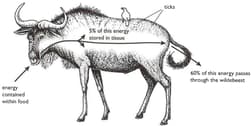
State three ways in which the energy may be used within the wildebeest.
The bird on the wildebeests back is an oxpecker that feeds both on blood-sucking parasites (ticks) living on the wildebeest, and on blood from the wildebeests wounds.
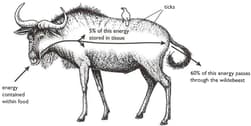
Draw a food web to show the feeding relationships of the organisms in the diagram.
The bird on the wildebeests back is an oxpecker that feeds both on blood-sucking parasites (ticks) living on the wildebeest, and on blood from the wildebeests wounds.
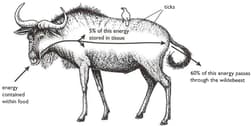
Explain why there must always be fewer oxpeckers than ticks in this food web.
The photograph below shows some root nodules from a pea plant, which is a type of legume.
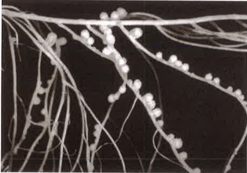
List four chemical elements that are found in proteins.
The photograph below shows some root nodules from a pea plant, which is a type of legume.

Nodules like those in the photograph develop on the roots of pea plants and other legumes when the soil is lacking in nitrate ions.
The photograph below shows some root nodules from a pea plant, which is a type of legume.

After the peas have been harvested, the plants are ploughed back into the soil. Describe what happens in the soil to convert dead plant material into nitrate ions that plants can absorb.
The photograph below shows some root nodules from a pea plant, which is a type of legume.
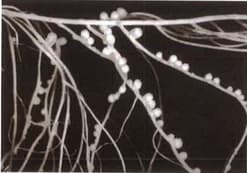
Nutrients in the soil can act as a limiting factor for crop growth. List three other factors that may limit the growth of a crop plant.
The soya bean aphid is an insect pest of soya bean plants in North America. The aphids can show an exponential growth rate where populations can double in two to three days under favourable conditions. The diagram below shows the growth of soya bean aphids in a field in North America during the growing season.
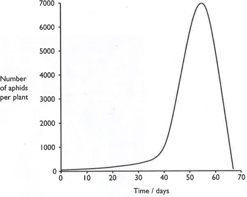
Suggest why the population of aphids did not increase rapidly until about day 40.
